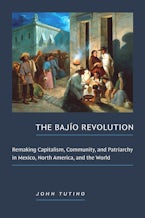In The Bajío Revolution, John Tutino examines how popular insurgents reshaped Mexico, the US, and global capitalism during the nineteenth century. After detailing New Spain’s silver-driven wealth, Tutino shows how the Bajío insurgency of 1810–1820 broke silver flows and Asian trades, opening markets to industrial cloth made in England of cotton made by enslaved hands in the US South - while Bajío women claimed pivotal roles making maize to sustain families and guerrilla bands. As Mexico gained independence in 1821, mining remained broken while family growers held strong. Then in the 1830s, a new silver-industrial capitalism fed by family maize makers rose in the Bajío. Women still led rural families and took on mill labor; one woman became Mexico’s leading silver capitalist. Facing that competition, in the 1840s the US invaded to claim Texas for cotton and slavery and California for gold. The new Mexican capitalism carried on until the US mobilized gold taken in war to join a global gold standard in the 1870s - blocking Mexico’s independent route to capitalism.
List of Illustrations xi
Prologue. Between Silver and Maize: New Spain and Mexico in the New World, 1550–1850 xiii
Introduction. The Revolution(s) That Remade Global Capitalism 1
Part I. Making Silver Capitalism, 1500–1810
1. A New World in the Bajío: Silver, Capitalism, and Patriarchy, 1550–1760 23
2. Shaking the New World: Global Wars, Capitalist Predations, and Imperial Crises, 1760–1810 46
Part II. Breaking Silver Capitalism, 1810–1820
3. The Hidalgo Revolt: Four Months That Shook New Spain 75
4. Insurgent Guanajuato: Claiming Maize, Making Community, Breaking Silver Capitalism, Rattling Patriarchy 103
5. Counterinsurgency Capitalism in Querétaro: Production, Patriarchy, and the End of Profit at La Griega 135
6. New Spain in Times of Revolution: Arming Power, Defending Property, Conceding Family Production 156
Part III. Seeking Mexico, 1820–1830
7. As the World Turned: Imperial Dreams, Capital Failures, National Challenges 181
8. Independent Guanajuato: Strong Communities, Strong Women, Independent Cultures 210
9. Querétaro After Insurgency: Agrarian Capitalism Falls, Families Rule Maize 236
10. Mexico in the Wake of Revolution: Oligarchs Fall, Women Press On, Families Make Maize, and More 272
Part IV. Making Silver-Industrial Capitalism, 1830–1860
11. A New Bajío: Silver Revives, Industry Rises, Landlords Struggle—and Family Growers Carry Everything 295
12. A New Capitalism: Silver Peaks, Industry Expands, Rancheros Thrive—and Family Growers Feed Everyone 324
Conclusion. Breaking the New Bajío: US Imperialism, Liberal Intrusions, French Invasion—and a Cross of Gold, 1845–1880 363
Epilogue. Mexico Since 1875: Silver Gone, Families Carry On—Until Globalizing Capital Claimed Maize 385
Acknowledgments 399
Appendix A. Querétaro Population, 1778–1860 407
Appendix B. Guanajuato Silver and Mining Population, 1810–1870 411
Appendix C. Production and Population at Querétaro, 1840–1855 421
Appendix D. Production and Work at Querétaro, 1840–1855 433
Appendix E. Mexican Population, Production, Trade, Revenue, and Debt, ca. 1861 445
Appendix F. Population and Production in Guanajuato, 1855–1876 453
Appendix G. The Bajío in Mexico, 1876–1895 461
Notes 465
Bibliography 509
Index

